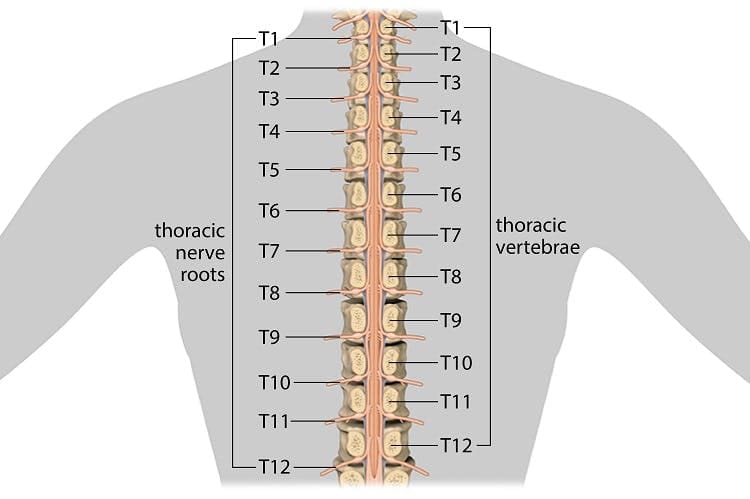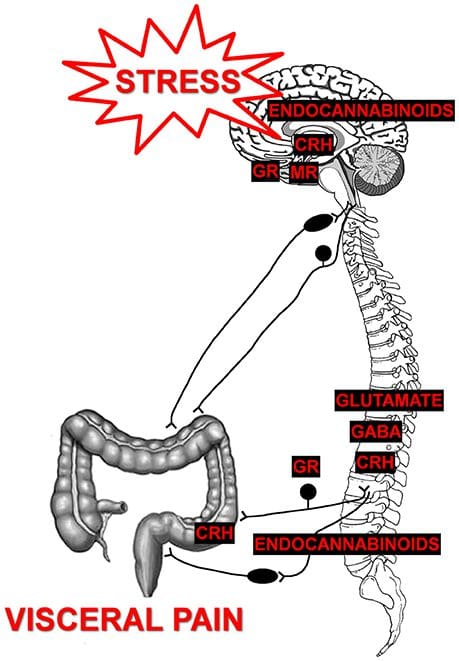Table of Contents
Introduction
The spine has three areas: cervical, thoracic, and lumbar in the back, encased with muscles, tissues, ligaments, and joints that help protect the spinal cord from injuries. With the spinal cord being part of the central nervous system, this long cord has many nerve roots that are spread all over the body and help function each section of the body. When the back muscles become damaged or injured in the thoracic region of the spine, it can cause painful symptoms and other issues that correspond with the thoracic spine. Today’s article will look at the thoracic spine, how back pain in the upper-mid section of the back, and how visceral referred pain affects the thoracic region in the body. We refer patients to certified, skilled providers specializing in osteopathic and chiropractic treatments that help those suffering from chest pains and thoracic back pain. We also guide our patients by referring to our associated medical providers based on their examination when it’s appropriate. We find that education is critical for asking insightful questions to our providers. Dr. Alex Jimenez DC provides this information as an educational service only. Disclaimer
Can my insurance cover it? Yes, it may. If you are uncertain, here is the link to all the insurance providers we cover. If you have any questions or concerns, please call Dr. Jimenez at 915-850-0900.
The Thoracic Spine
Have you been experiencing herniation in the upper-mid section of your back? Have you felt chest pain occur frequently? Do your back muscles feel stiff or constantly ache even after you stretch? All these symptoms are signs that affect the thoracic region of the spine. Research studies have defined the three spinal areas: the cervical, thoracic, and lumbar help keep the upper half of the body upright. The thoracic area of the spine has added support from the rib cage and allows the body to rotate and flex the upper body. The thoracic region of the spine is also the first curvature that is tight enough to protect the vital organs and loose enough to allow respiratory movement in the body. Additional research studies have also mentioned that the thoracic segments in the spine are susceptible to injuries that can affect the back entirely. The thoracic segments can succumb to structural alterations, disc herniation, and even trauma in the spine from environmental factors like lifting or carrying heavy objects, muscle strain, and forceful impact.
How Thoracic Pain Affect The Body
When the thoracic region of the spine begins to suffer from environmental factors or traumatic events, it can affect the body and aggravate the nerves that encase the spinal column. Research studies have found that when the thoracic spine has succumbed to injuries, it can affect the upper half of the body. Structural changes in the thoracic T 1 through 3 regions of the spine can cause the cervical area to develop neck pain. This causes restricted segmental mobility in the cervical and thoracic regions of the spine. Another research study has mentioned that individuals suffering from thoracic pain will often complain about paravertebral pain aggravated by prolonged standing, hyperextension, and even hyper rotation in the thoracic spinal column. When this happens, it can cause discomfort to the individual and limit their range of motion since their muscles are stiff. Thoracic pain can even affect the corresponding muscles connected to the body’s internal organs.
Referred Pain Affect The Thoracic Spine-Video
Have you felt muscle stiffness in your upper-middle back? Have you been dealing with neck or chest pain? Have inflammatory issues affecting your esophagus? Many of these are signs and symptoms of visceral referred pain affecting the thoracic region of the spine. The video above explains how visceral referred pain can affect the thoracic spine and the corresponding muscle and organs in the area. Research studies have defined pain as damaged nociceptive sensory nerves that affect the peripheral tissues in the face. The broken nerve roots can affect one portion of the body but also a different section of the body. Additional research studies have also found that visceral pain affecting the thoracic regions of the spine can impact the cardiovascular system. This is due to hypertension caused by chronic stress from environmental factors.
Visceral Referred Pain Affecting The Thoracic Region
Research studies have noticed that thoracic spinal pain can become a common site for inflammation, degenerative discs, and other issues contributing to pain and disability in the spine. Visceral pain is a complex disorder that can cause the surrounding muscles and organs in the thoracic region to be compromised. When the body is suffering from visceral referred pain, the thoracic region of the spine will also begin to suffer. Additional research studies have found that visceral referred pain that affects the thoracic neurons will also affect the esophageal and cardiac input to the cardiovascular and gut systems. When the affected thoracic neurons begin to cause heart and esophageal problems, these two organs become hypersensitive due to noxious stimulation.
Conclusion
The spine has three areas: the cervical, thoracic, and lumbar, which help keep the body upright and is encased with muscles, tissues, and ligaments that protect the spinal cord from injuries. Injuries that affect the thoracic regions of the back can cause problems to the corresponding muscles and the internal organs, especially in the gut and cardiovascular systems. These organs become hyper-sensitive and can make the body develop hypertension and other issues that can make the body dysfunctional. When individuals realize that their upper-middle back pain in the thoracic region can affect their cardiovascular system, they can find ways to treat their back pain and prevent cardiovascular issues from forming.
References
Briggs, Andrew M, et al. “Thoracic Spine Pain in the General Population: Prevalence, Incidence and Associated Factors in Children, Adolescents and Adults. A Systematic Review.” BMC Musculoskeletal Disorders, BioMed Central, 29 June 2009, www.ncbi.nlm.nih.gov/pmc/articles/PMC2720379/.
Brumovsky, P R, and G F Gebhart. “Visceral Organ Cross-Sensitization – an Integrated Perspective.” Autonomic Neuroscience: Basic & Clinical, U.S. National Library of Medicine, 16 Feb. 2010, www.ncbi.nlm.nih.gov/pmc/articles/PMC2818077/.
Gkasdaris, Grigorios, et al. “Clinical Anatomy and Significance of the Thoracic Intervertebral Foramen: A Cadaveric Study and Review of the Literature.” Journal of Craniovertebral Junction & Spine, Medknow Publications & Media Pvt Ltd, 2016, www.ncbi.nlm.nih.gov/pmc/articles/PMC5111324/.
Joshi, Shriya, et al. “Thoracic Posture and Mobility in Mechanical Neck Pain Population: A Review of the Literature.” Asian Spine Journal, Korean Society of Spine Surgery, 3 June 2019, www.ncbi.nlm.nih.gov/pmc/articles/PMC6773982/.
Murray, Greg M. “Guest Editorial: Referred Pain.” Journal of Applied Oral Science : Revista FOB, Faculdade De Odontologia De Bauru Da Universidade De São Paulo, 2009, www.ncbi.nlm.nih.gov/pmc/articles/PMC4327510/.
van Kleef , Maarten, et al. “10. Thoracic Pain.” Pain Practice : the Official Journal of World Institute of Pain, U.S. National Library of Medicine, 2010, pubmed.ncbi.nlm.nih.gov/20492577/.
Ward, John, et al. “Immediate Effects of Upper Thoracic Spine Manipulation on Hypertensive Individuals.” The Journal of Manual & Manipulative Therapy, Maney Publishing, Feb. 2015, www.ncbi.nlm.nih.gov/pmc/articles/PMC4459143/.
Waxenbaum, Joshua A, et al. “Anatomy, Back, Thoracic Vertebrae – Statpearls – NCBI Bookshelf.” In: StatPearls [Internet]. Treasure Island (FL), StatPearls Publishing, 12 Aug. 2021, www.ncbi.nlm.nih.gov/books/NBK459153/.
Disclaimer
General Disclaimer
Professional Scope of Practice *
The information herein on "Visceral Pain Affecting Thoracic Region Of The Back" is not intended to replace a one-on-one relationship with a qualified health care professional or licensed physician and is not medical advice. We encourage you to make healthcare decisions based on your research and partnership with a qualified healthcare professional.
Blog Information & Scope Discussions
Welcome to El Paso's Premier Wellness and Injury Care Clinic wellness blog, where Dr. Alex Jimenez, DC, FNP-C, a board-certified Family Practice Nurse Practitioner (FNP-C) and Chiropractor (DC), presents insights on how our team is dedicated to holistic healing and personalized care. Our practice aligns with evidence-based treatment protocols inspired by integrative medicine principles, similar to those found on dralexjimenez.com, focusing on restoring health naturally for patients of all ages.
Welcome to El Paso's Premier Wellness and Injury Care Clinic & wellness blog, where Dr. Alex Jimenez, DC, FNP-C, a board-certified Family Practice Nurse Practitioner (FNP-C) and Chiropractor (DC), presents insights on how our team is dedicated to holistic healing and personalized care. Our practice aligns with evidence-based treatment protocols inspired by integrative medicine principles, similar to those found on dralexjimenez.com, focusing on restoring health naturally for patients of all ages.
Our areas of chiropractic practice include Wellness & Nutrition, Chronic Pain, Personal Injury, Auto Accident Care, Work Injuries, Back Injury, Low Back Pain, Neck Pain, Migraine Headaches, Sports Injuries, Severe Sciatica, Scoliosis, Complex Herniated Discs, Fibromyalgia, Chronic Pain, Complex Injuries, Stress Management, Functional Medicine Treatments, and in-scope care protocols.
Our information scope is limited to chiropractic, musculoskeletal, physical medicine, wellness, contributing etiological viscerosomatic disturbances within clinical presentations, associated somato-visceral reflex clinical dynamics, subluxation complexes, sensitive health issues, and functional medicine articles, topics, and discussions.
We provide and present clinical collaboration with specialists from various disciplines. Each specialist is governed by their professional scope of practice and their jurisdiction of licensure. We use functional health & wellness protocols to treat and support care for the injuries or disorders of the musculoskeletal system.
Our videos, posts, topics, subjects, and insights cover clinical matters, issues, and topics that relate to and directly or indirectly support our clinical scope of practice.*
Our office has reasonably attempted to provide supportive citations and has identified the relevant research studies or studies supporting our posts. We provide copies of supporting research studies available to regulatory boards and the public upon request.
We understand that we cover matters that require an additional explanation of how they may assist in a particular care plan or treatment protocol; therefore, to discuss the subject matter above further, please feel free to ask Dr. Alex Jimenez, DC, APRN, FNP-BC, or contact us at 915-850-0900.
We are here to help you and your family.
Blessings
Dr. Alex Jimenez DC, MSACP, APRN, FNP-BC*, CCST, IFMCP, CFMP, ATN
email: coach@elpasofunctionalmedicine.com
Licensed as a Doctor of Chiropractic (DC) in Texas & New Mexico*
Texas DC License # TX5807
New Mexico DC License # NM-DC2182
Licensed as a Registered Nurse (RN*) in Texas & Multistate
Texas RN License # 1191402
ANCC FNP-BC: Board Certified Nurse Practitioner*
Compact Status: Multi-State License: Authorized to Practice in 40 States*
Graduate with Honors: ICHS: MSN-FNP (Family Nurse Practitioner Program)
Degree Granted. Master's in Family Practice MSN Diploma (Cum Laude)
Dr. Alex Jimenez, DC, APRN, FNP-BC*, CFMP, IFMCP, ATN, CCST
My Digital Business Card






















